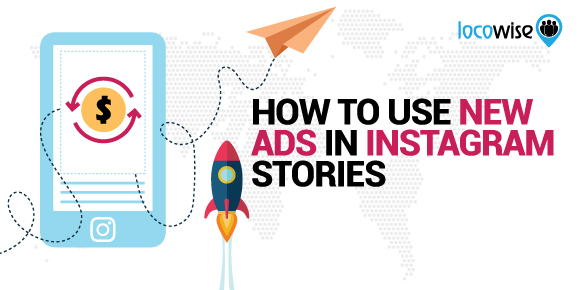How To Use New Ads In Instagram Stories
Catherine Hayden posted on 22 March 2017
Instagram recently rolled out ads in stories to all businesses. What does this mean for you? More reach and, potentially, far more engagement. Using the new feature is surprisingly easy and if you believe in the power of video content as much as we do, making space for them in your social media strategy right away is a no-brainer.
Like Snapchat, Only Different
Within five months of its launch in late 2016, 150 million Instagrammers were using stories daily. According to Instagram, one in five stories gets a direct message from a viewer – that’s good engagement. Today 70 percent of people on Instagram follow at least one business, and one-third of the most viewed stories on the platform are posted by businesses.

When stories were first rolled out on Instagram, there was some criticism that they were very similar to what Snapchat was already offering. There were even a few parodies circulating on YouTube, like this one.
What made Instagram’s stories most different to Snapchat’s was reach. Besides the fact that Snapchat targets a younger demographic, it only has in the region of 158 million daily viewers. With 300 million daily viewers, 500 million monthly viewers, and 250 million people using its direct messaging service, Instagram is leagues ahead of Snapchat on that front.
Nike, who posted a story on the day Instagram launched the feature in 2016, is a case in point. They generated 800,000 views in 24 hours. It’s very unlikely that kind of reach would have been possible if they had done the same on Snapchat.
Why You Want To Own Stories Ads
James Quarles, VP of business at Instagram, explains that stories make consumers feel closer to businesses. Because businesses can use the same tools as consumers, like stickers and illustrations, they ‘are seeing the opportunity of Stories as a new layer of intimacy that is raw and unfiltered. It’s a new way to deepen a relationship between a business and a person.’
Paid social media is almost without exception the driving force behind any successful digital marketing campaign. Combining fine-tuned targeting with content that people can relate to (and which doesn’t feel spammy or forced) is very powerful when it comes to reach and engagement. Instagram stories excel at this.
Because Instagram is owned by Facebook, stories ads use the same targeting and measurement tools as the world’s most popular social media platform. The link between Instagram and Facebook allows you to use insights from the one channel and apply them to the other. For example, you could take audiences who have seen your stories ads and then target them on your main Instagram or Facebook feeds. Conversely, stories ads can be targeted at audiences that have seen a promoted post on either of the two feeds.

How To Create Stories Ads
Creating an Instagram story ad is very simple if you’re used to advertising on Facebook. You can choose to upload a single still image or a video up to 15 seconds long. When the ad starts running, it will appear between people’s other stories just like a standard Instagram ad appears between other posts on a user’s feed.
Here’s a step-by-step guide to creating your own ad in Instagram stories:
1. Go to Facebook Ads Manager
2. Click on ‘Create an Ad’
3. Choose the ‘Reach’ objective
4. Click ‘Placements’ in the Ad Set section
5. Pick ‘Edit Placements’ and then select Instagram
6. Click ‘Stories’
7. Follow the rest of the steps needed to complete your campaign, as you’d usually do
8. Review your changes and go for it
9. Monitor your progress using your analytics tools
Worth Watching: Misa’s Miso Story
Airbnb was one of the first brands to try out ads on Instagram stories. They very recently used the feature to promote one of their ‘Experiences’, where local hosts offer travellers a tailored trip. In the story they show short video clips of people making miso with their host, Tokyo native and miso expert Misa.
The 14-second story is a combination of stills and video clips, set to an upbeat soundtrack. The sound doesn’t cover some background noise, though. You hear soya beans being poured into a stainless steel bowl and Misa speaking to her guests. This, combined with footage that looks like it could have been taken on anyone’s mobile phone, makes the experience seem very real.
Eric Toda, the global head of social marketing and content at Airbnb, said that, ‘Immersive storytelling through Instagram Stories engages and invites our community to be part of an adventure. By creating and publishing experience-driven stories, we can truly captivate and reach travelers wishing to book aspirational trips on Airbnb.’
Instagram is, of course, the ideal place to get the attention of foodies and travellers alike.
Learn From The Best
There’s a lot to be learnt from Airbnb’s Miso Culture promotion on Instagram stories. We think these are the most important pointers to keep in mind when you start your own campaign:
● Targeting
As a rule, if you’re already promoting a specific product or service on Instagram, stories targeted to the same audience could be a good idea. Lifestyle- and food-related images and videos have always been winners on Instagram, so keep this in mind when you’re considering new strategies – Airbnb did.
● Breaking the rules
The 80/20 rule says that around 80 percent of your content should be focused on educating and engaging your audience, and just 20 percent should be promotional. Airbnb break this rule by using the vast majority of this story to engage people and educate them around a service they offer. Just one clip (that’s under 10 percent of the entire video) is branded and has a call to action. It’s best practice to stay close to the 80/20 rule when you look at your overall content strategy, but the length of stories makes it possible to break the rules a little if it’s going to make your content more compelling.
● Nailing narrative
Stories ads should tell a story that has a beginning, a middle, and an end. It’s helpful to think of them as very short videos rather than a selection of clips – they need to be scripted and planned like any other video would. The Airbnb Miso Culture ad actually tells two stories, which is ideal. The first is about the product, and the second is about the brand. Watching the video, you should be able to tell that the story is set in Japan (the opening shot), that it’s about creating something edible (the food stills and the footage of people in the kitchen), and that the end result is drinking a delicious bowl of soup (closing clips). The brand’s key values come through in this story: ‘live like a local’, and ‘have real experiences’.
● Immerse your audience
To create an immersive experience, you want to involve all the senses that you possibly can to get your message across. Seventy percent of stories on Instagram are viewed with sound, so make a point of including it in your videos. It is possible to use video to convey things that you can smell and taste, too. The Miso Culture story uses hot steam rising to make viewers imagine what the soup might smell like, the sound of soya beans to help you imagine what the hands getting ready to grind them are feeling, and footage of people completely eating the miso to illustrate just how delicious it is. Faces have been proven to get more likes on Instagram, too, so include people your audience can relate to in videos where you can.
Up Your Film Game
Now that you know how to post a promoted Instagram story and what a good one looks and sounds like, here are a few tips to help you up your game when it comes to filming content.
1. Plan ahead so you have time to work out your shots, your sound, and how you’re going to use stills and video to tell your story.
2. Invest in a tripod. Stories should look natural, but never amateurish. A shaky hand or an accidental knock could destroy an otherwise perfect shot or clip.
3. Get an external mic. Most mobile phones don’t come out of the box ready to record really good audio and good sound really pulls viewers in.
4. Invest in a small LED light or two. Shooting in low light creates grainy video, and natural lighting won’t always be as bright as you need it to.
5. Use editing software to pull it all together. No matter how well you plan, there will always be something you need to cut out.
In closing, a quick bonus tip: Start now if you want to get ahead of the competition.




